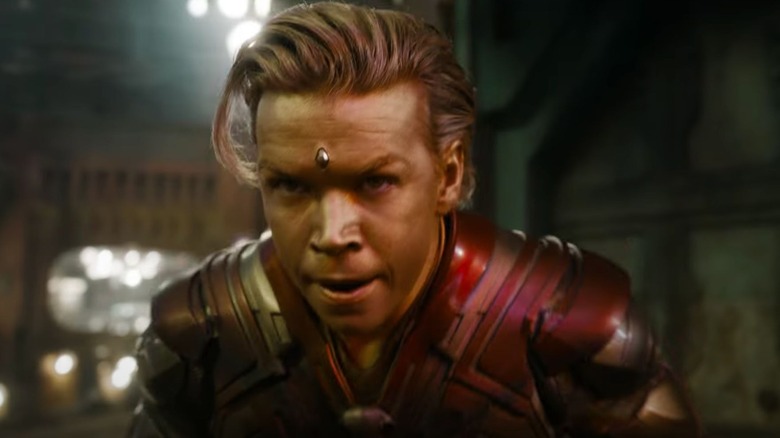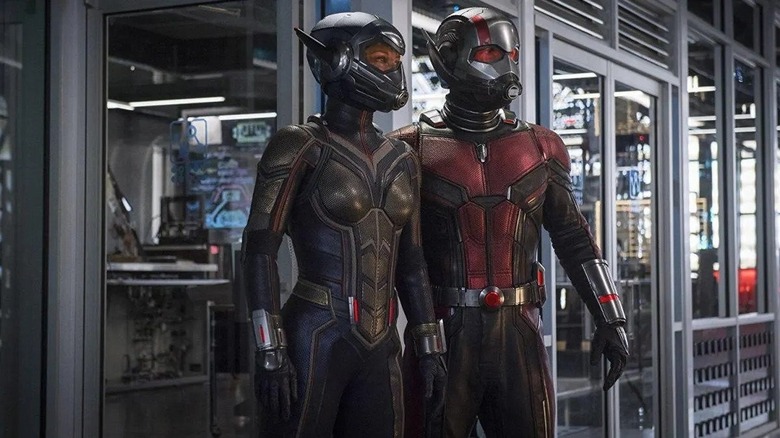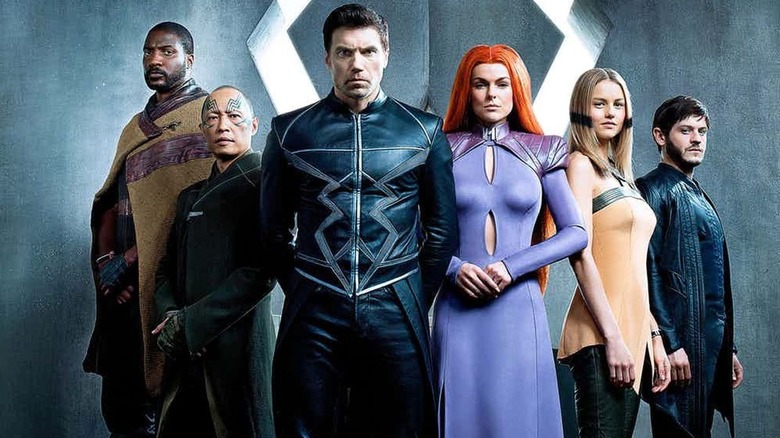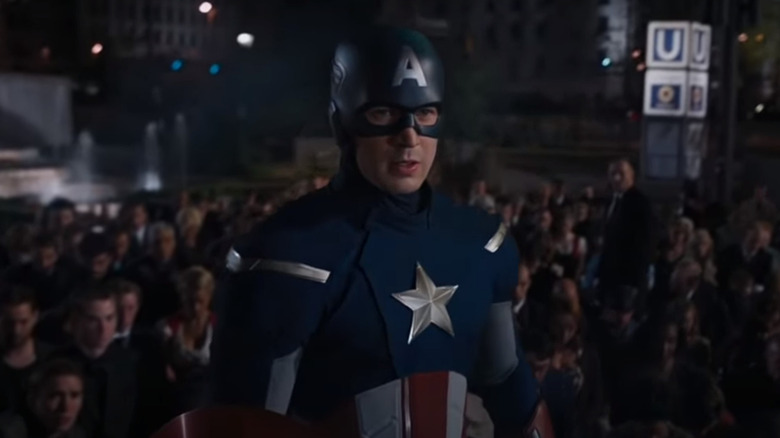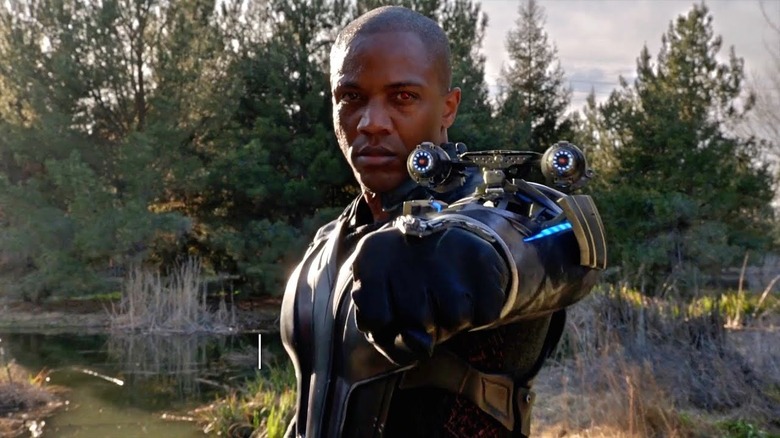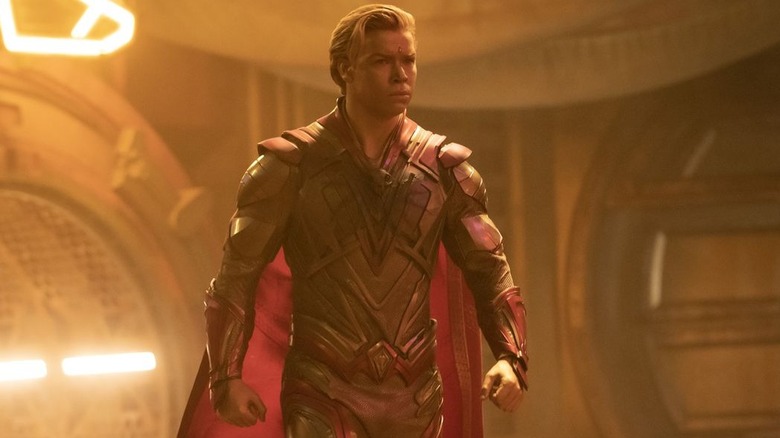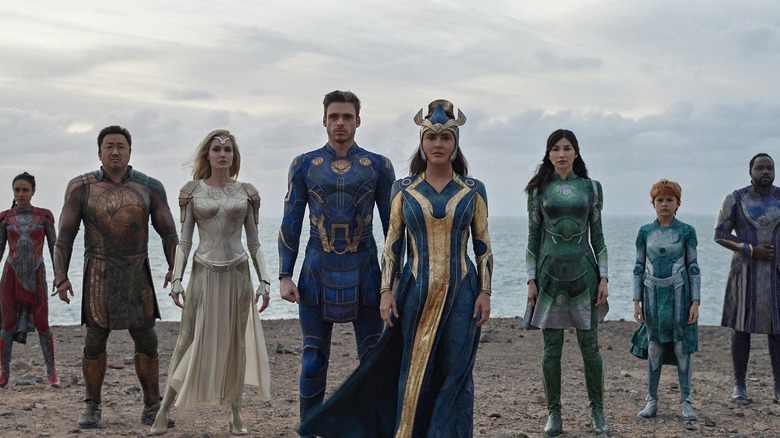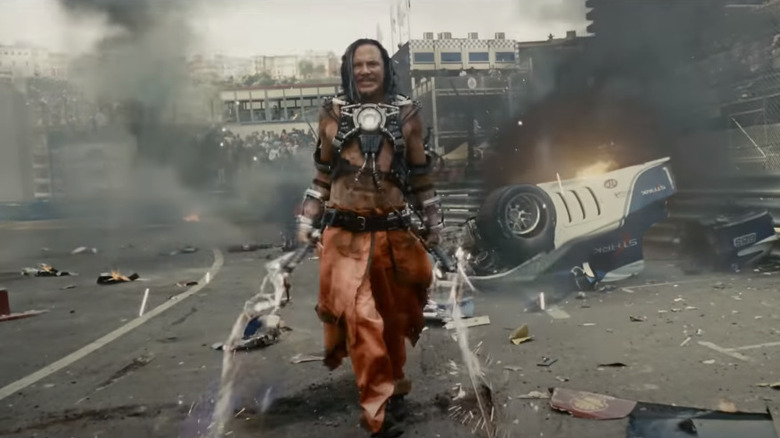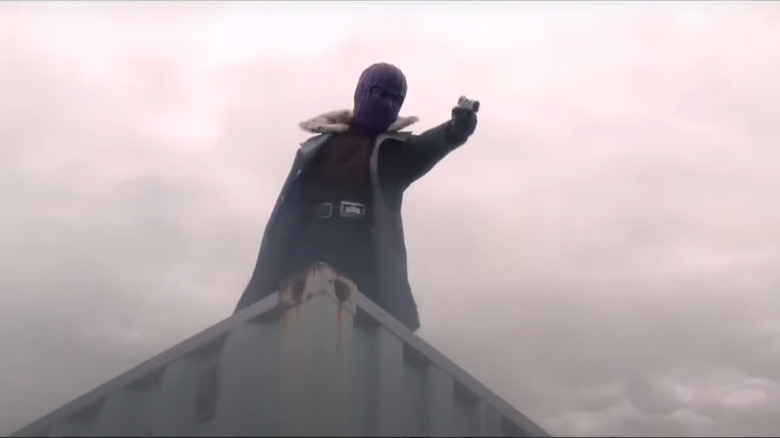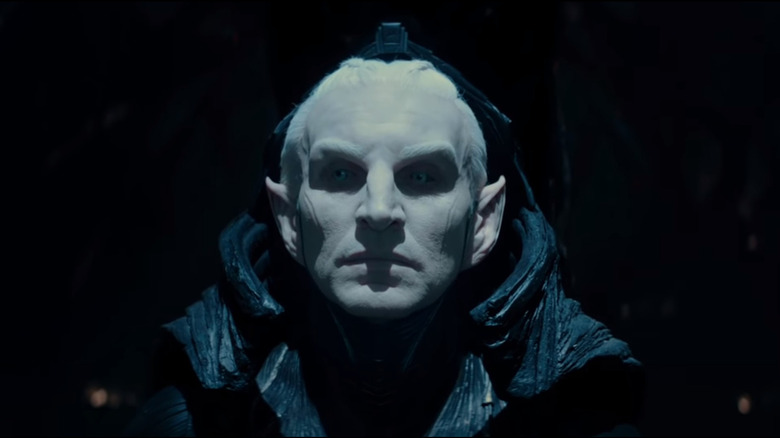The Most Controversial MCU Costumes Of All Time
Ever since the Marvel Cinematic Universe kicked off with 2008's "Iron Man," fans around the world have delighted at seeing some of their favorite comic book characters share the screen with one another in an ever-expanding world. For the most part, Marvel Studios boss Kevin Feige and the countless writers, directors, actors, and others who've helped shape the MCU have delivered wildly entertaining shows and movies while also staying true to what made the source material so captivating. From classic plotlines to iconic panels to lesser-known characters, the MCU's creators have done a stellar job of transposing some of the most beloved elements from the comic books to both the big and small screen.
Still, because of how different comics are from television and film, numerous changes have been made to adapt these larger-than-life characters to a live action medium. Some of these decisions make sense; what may work on a colorful page may not work in front of a camera, so changes are often required to bring comic book characters to life. However, fans haven't been happy with every creative choice that Feige and company have made. One of the biggest sticking points for audiences has been the costumes, which has led to no shortage of online chatter about why certain design aspects were introduced. Let's take a look at some of the most controversial MCU costumes of all time.
The Wasp
Evangeline Lilly's Hope van Dyne was introduced in 2015's "Ant-Man," and while she played a major supporting role in the film, fans were a bit disappointed when she didn't suit up as the Wasp. However, we were given a little treat in the end credits scene, which saw her father Hank Pym (Michael Douglas) reveal a version of her missing mother's Wasp suit. To this, Hope responds with a cool, "It's about damn time." For many fans, her statement wasn't simply related to the character's desire to follow in her mother's footsteps –- it was a statement of how long it took to bring such a beloved character from the comics to the big screen.
2018's "Ant-Man and the Wasp" saw a Marvel heroine get top billing for the first time (albeit shared with a male character), so anticipation was growing over finally getting to see Hope jump into action. Of course, the excitement dwindled when an official still was released from the film that saw Ant-Man (Paul Rudd) in a new suit alongside Wasp in her suit first shown in the previous movie. Apparently, many people on Twitter thought that the front design depicted male genitalia that was aiming towards her crotch, with accusations of sexism hurled at the costume's designers. Why they didn't raise an uproar three years earlier when the suit was first revealed is puzzling, to say the least. Luckily, the film's costume designer Louise Frogley explained her creative process in a Refinery29 interview, and nowhere does she mention male anatomy.
The Inhumans
By 2017, the Marvel Cinematic Universe could seemingly do no wrong (other than "Iron Man 2" and "Thor: The Dark World," that is). Considering the massive success achieved by giving the spotlight to largely obscure characters like Ant-Man and the Guardians of the Galaxy, Marvel Studios decided to bring the Inhumans to the big screen ... only to shuffle them over to the small screen in the form of an eight-episode miniseries. Still, the studio had struck gold with its shared universe of Netflix series and ABC's "Agents of S.H.I.E.L.D." What could go wrong?
As it turns out, pretty much everything. "Inhumans" was absolutely eviscerated by critics and fans alike, who ridiculed almost every aspect of the show, from the characterization to the story to the tone and more. But even before the series was unleashed on an unsuspecting public, one aspect was singled out: the suits. As soon as an official still from the series was released, social media users ripped costume designs to pieces like a pack of hungry piranha.
Their disgust was understandable. Before "Inhumans," Marvel Studios had largely spared no expense when it came to visualizing characters for live action, but what we got here were ensembles that looked like they were purchased at Spirit Halloween on November 1st. Actor Jordan Ross tweeted the following: "This #Inhumans cosplay is pretty good. Oh wait... Those are the ACTUAL costumes for the Inhumans IMAX TV show? Ummm... #Yikes." Yikes, indeed.
Captain America
Captain America (Chris Evans) has gone through multiple costumes in the MCU, many of which were inspired by the looks he sported throughout the decades on the page. The very first suit he donned in "Captain America: The First Avenger" was an intentionally cheesy, dated, ensemble that paid tribute to his comic book introduction in the 1940s. However, once he got fed up with selling war bonds and decided to join the war effort, Cap opted for something more rugged, similar to what he wore in the "Ultimates" comics. While on the run from the authorities after his fallout with Iron Man (Robert Downey Jr.) in "Civil War," Cap adorned himself with a darker style, reflecting his Nomad persona. And it was in "Avengers: Endgame" that he finally donned the iconic scale mail he'd been wearing since his earliest comic days.
However, there's one Captain America costume that fans weren't happy with: that which he wore in 2012's "The Avengers." Within the movie, S.H.I.E.L.D. Agent Phil Coulson (Clark Gregg) claims that he had a hand in its design, and considering his deep love for Cap, it's completely fair to put the blame squarely on him for the annoyingly cartoony appearance. Marvel Studios is often blamed for making its heroes' costumes too busy and "grounded" in an attempt to make them more practical. However, this iteration of Cap's suit saw the studio commit the exact opposite sin, which resulted in a simple, brightly-colored set of threads that recalled the hokey USO suit he wore in "The First Avenger," but with far more misplaced seriousness.
Iron Fist
Following the fairly positive response to the previous Marvel shows on Netflix — "Daredevil," "Jessica Jones," and "Luke Cage" — "Iron Fist" was released in 2017 to a considerably less enthusiastic reception. Despite a handful of decent action scenes, fans and critics largely balked at the show's wandering storyline, weak performances, and lack of a strong villain. In short, it made for a middling lead-in to "The Defenders," Marvel Television's attempt to recreate the crossover magic of the "Avengers" films on the small screen.
The show may have scored more points with audiences if its protagonist wore his famous green-and-yellow costume from the comics. Instead, he wore regular street clothes which did nothing to garner favor with fans of the source material. Sure, the Netflix versions of the characters were more gritty and down to Earth, but that doesn't mean the show's creators couldn't have done something to show they actually read an issue or two of "Power Man & Iron Fist."
Danny Rand's (Finn Jones) on-screen look felt like a slap in the face to many who followed the character for years and waited patiently for a live-action iteration. As Sean Aitchison wrote for CBR, "Although there was an in-story justification for the absence of Danny's costume, it still felt like a pretentious rejection of Iron Fist's comic roots. If not for his chest tattoo and his glowing fists, it would be impossible to realize that Danny was actually The Immortal Iron Fist."
Deathlok
Deathlok was never an A-list Marvel Comics character, but having been around since the 1970s, he's had enough of an audience to justify continual appearances over the years. Many characters have taken on the Deathlok identity, but the main qualities they've all shared are that they were once dead humans who were revived with advanced technology and given an arsenal of deadly cybernetic weapons. The style most associated with Deathlok is that of a corpse-like figure with futuristic armor and half their face covered in deadly machinery.
It's a pretty heavy metal look that's reminiscent of the T-800 from the "Terminator" films, so there was a precedent when it came to realizing a version of the character in live action form. Unfortunately, Deathlok's grand live-action debut on "Agents of S.H.I.E.L.D." left fans wanting more. A lot more. In the show, he is a regular man named Mike Peterson (J. August Richards) who is turned into a cyborg with expensive high-tech abilities by Hydra experimentation.
Hydra apparently had its funding cut, so they outfitted Peterson with plastic armor that made him look like a "Power Rangers" villain. We do get the occasional glimpse of his metallic interior, but it feels too much like the show's creators saying, "There, happy? Now shut up and embrace this more 'grounded' version of the character in a series about aliens, superpowers, and time travel."
Adam Warlock
Adam Warlock is another Marvel Comics character who's been relatively unknown to mainstream audiences. Mostly relegated to the cosmic side of the comic book universe, Adam Warlock is a being who was synthetically created to be the next step in human evolution, playing a major role in such beloved storylines as "The Infinity Gauntlet" and "Annihilation: Conquest." The character made his live action debut in 2023's "Guardians of the Galaxy Vol. 3" played by Will Poulter. In the film, he's the creation of Ayesha, who sends him to get revenge on the Guardians, only for him to end up as a member of the team.
The MCU version of Adam Warlock borrows much of his backstory from the comics, which is also the source of his costume's red and gold color scheme. However, in true Marvel Studios fashion, his suit is given far too much detail in the form of tactical armor replacing the traditional superhero spandex. Fans weren't terribly fond of the militaristic stylings given to the character, who was historically so powerful that he didn't need additional padding to bulk him up. At least the film's costume designers kept his cape and forehead gem; funny how they thought a crystal embedded in someone's skull wasn't too weird, but red underwear somehow crossed the line.
The Eternals
The Eternals were never anyone's favorite characters, mostly due to the fact that they occupied such a small place in the Marvel Comics pantheon. Other than a handful of dedicated series, the race of humanoid space gods appeared only sporadically in other titles since comic book legend Jack Kirby created them in the 1970s. On its surface, bringing such obscure characters to the big screen was a bold move on Marvel Studios' part, but since they were riding high on the gargantuan success of "Avengers: Endgame," who could blame them for taking such a risk?
Well, it turns out that their risk didn't pay off. The film received a mixed reaction from audiences, due in no small part to its predictable plot and boring characters. Of course, the Eternals' bland fashion sense did little to make them stand out from the rest of the MCU's growing roster of heroes. As one Reddit user pointed out, "At some point you really start to notice how a lot of the Marvel Cinematic Universe's costumes just feel the same. Whether your character is an alien god, a space pirate, or just a human billionaire, you all shop at the same outlet." One would hope that immortal gods who've been around since the birth of humanity would be treated with a little more respect.
Whiplash
Whiplash (Mickey Rourke) from "Iron Man 2" is sort of a composite of the comics character of the same name and the Crimson Dynamo, both of whom are longtime nemeses of ol' Shellhead. In the film, Whiplash is Ivan Antonovich Vanko, the son of a Russian scientist who worked with Tony Stark's father decades earlier, before getting kicked out of the U.S. for illegally selling advanced technology. Either Ivan doesn't know that his father was a criminal or he doesn't care. He sets out to get revenge on Stark, believing that the best way to do that is arm himself with some dangerous tech.
Whiplash's first attempt to take down Iron Man is a little short in the style department, as he attacks wearing bright orange pants, a couple of electrical whips, and that's it. Other than the whips, nothing about it is based on his comic book counterpart(s), but fans would've been more forgiving of it if it had led to something greater later. It did not. Instead, we got a bland, bulky rip-off of an Iron Man suit whose only saving grace is that it's barely in the film; as HamiltonParker wrote for ComicBookMovie, Whiplash's "final appearance (which received a laughably short amount of screentime) is so generic that it's hard to remember what Whiplash even looked like when he finally donned his own suit of armor."
Baron Zemo
Baron Helmut Zemo is a longtime Captain America villain, a high ranking Hydra leader who always shows up with a different plan to conquer the world. His MCU counterpart is quite a bit different. Zemo (Daniel Brühl) first appeared in "Captain America: Civil War" as a Sokovian soldier who blames the Avengers for his family's death after their battle with Ultron devastated their country. He returns in the Disney+ series "The Falcon and the Winter Soldier," in which he's recruited to help track down the Flag Smashers.
Zemo donned two outfits that failed to do his iconic comic book look justice. "Civil War" mostly sees him wearing regular clothes, prompting many fans to wonder why he was even in the film as he was such a departure from the way he's portrayed in the source material. For the Disney+ series he eventually puts on a purple mask that brings him a little closer to his original look, but it's only for one scene, and did little to thrill fans with enthusiastic recognition.
Marvel's failure to recreate the villain's suit was pointed out by Adeolu Adeoye of GameRant, who wrote, "Marvel's villains feature some of the least live-action-friendly designs in the comic universe. Baron Zemo however, isn't exactly one of them. His full suit is a bit much for the MCU, but his general color scheme and theming should have been fairly easy to adapt."
Malekith
Malekith has been plaguing Thor in the comics for decades, so fans were looking forward to his live-action debut in 2013's "Thor: The Dark World." Played by Christopher Eccleston, the cinematic version of Malekith and his Dark Elf brethren have been in suspended animation for millennia following a battle with Odin's father Bor and the Asgardians. However, once Jane Foster (Natalie Portman) is exposed to the Aether, Malekith and his army are reawakened. The ensuing attack on Asgard leads to the murder of Thor's mother, Frigga (Rene Russo). Thor (Chris Hemsworth) ultimately thwarts Malekith with the help of his brother Loki (Tom Hiddleston).
Despite being played by the immensely talented Eccleston, Malekith has gone down as one of the worst MCU villains ever. Not only was he devoid of personality or a compelling arc, he looked absolutely nothing like his comic book counterpart. Instead of the sinister black and white face and wild, heavy metal hairdo, we got a lame looking humanoid with pale skin and tied-back hair. Quinn Levandoski of ScreenRant wrote, "Malekith spent most of the movie with bright white skin and hair that washed out visual definition, only to receive a climactic burn somewhat mirroring his two-toned comic appearance." Yup, all we got was a tiny tease of what the character could've been, but that amounted to little more than an insult to comic book fans.
